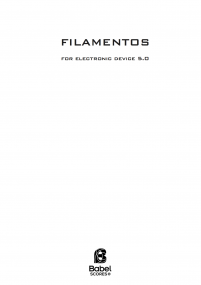For Hermann Markus
12,36 €
Digital version (+0,00 €) instant download
Printed format (+14,80 € printing and shipping). Colissimo7-14 days aprox.
When you buy a score, you can contact the composer right here!
Specifications
Region
Europe
Estimated Duration
6 - 10min
Date
2002
ISMN : 979-0-2325-0915-0
In Stock
Notes on this piece For Hermann Markus is written as a memorial piece to Hermann Markus Pressl, my firstcomposition teacher, who died in 1994. The lyrical incantations of the mezzo-soprano are meant to capture the celebratory nature of the work. The physical location of each of the three quintets is as follows: strings front and rear; woodwinds along the sides; percussion and brass at the corners of the stage. The mezzo-soprano is placed behind the audience and hidden from view. The layout does not merely suggest a theatrical element; instead, the focus on an unconventional spatial placement of performers enables a diffuse mix of sounds.
In the past years I have composed a series of pieces based on an empirical compositional approach in an attempt to pursue "what the Greeks did not know: uncertainty." I wanted to put aside the convenience that systems, methodologies and theories provide to a composer, although I still think that they are useful exercises for the mind. For the act of composing, however, infinite time, empty space, twelve notes (more or less), memory, and desire should be more than enough. For Hermann Markus is a similar attempt on a large scale. Those who are familiar with my music will recognize the use of repetitive patterns, faint occasional notes and temporal accents in an empty space, textural variations on one note, the abnegation of thematic/motivic elaboration, and layers of textural streams. To those I added some other features: events are occasionally called forth and dissolve in an instant and abrupt positions within the narrative of the work.
A central aspect of the deepest structural layer of the work is the manipulation of a sonority I label the “Adelma Chord,” a sonority which, in fact, appears in many of my compositions. The chord comprises in ascending order: a semitone; two augmented fourths; and another semitone (b, c, f sharp, b sharp, c sharp). It is symmetrical sonority around the axis pitch f sharp. The chord governs the organization of the tonal centers in a macro-structural sense: c sharp (from the beginning—4’08”); f sharp (8’10”—11’00”); b and c (14’00”—to the end).A fundamental premise of the composition involves an essential contradiction between forward motion and stasis. The work exhibits an evolving stream of musical ideas, wherein the instrumental forces are variously divided and subdivided. And yet, repetitive patterns organize the discrete moments that comprise the larger whole, creating points of repose, which, at times, inhibits forward motion, resulting in the impression of a total cessation of movement.
Add to a playlist
- Login to create your own lists
In the past years I have composed a series of pieces based on an empirical compositional approach in an attempt to pursue "what the Greeks did not know: uncertainty." I wanted to put aside the convenience that systems, methodologies and theories provide to a composer, although I still think that they are useful exercises for the mind. For the act of composing, however, infinite time, empty space, twelve notes (more or less), memory, and desire should be more than enough. For Hermann Markus is a similar attempt on a large scale. Those who are familiar with my music will recognize the use of repetitive patterns, faint occasional notes and temporal accents in an empty space, textural variations on one note, the abnegation of thematic/motivic elaboration, and layers of textural streams. To those I added some other features: events are occasionally called forth and dissolve in an instant and abrupt positions within the narrative of the work.
A central aspect of the deepest structural layer of the work is the manipulation of a sonority I label the “Adelma Chord,” a sonority which, in fact, appears in many of my compositions. The chord comprises in ascending order: a semitone; two augmented fourths; and another semitone (b, c, f sharp, b sharp, c sharp). It is symmetrical sonority around the axis pitch f sharp. The chord governs the organization of the tonal centers in a macro-structural sense: c sharp (from the beginning—4’08”); f sharp (8’10”—11’00”); b and c (14’00”—to the end).A fundamental premise of the composition involves an essential contradiction between forward motion and stasis. The work exhibits an evolving stream of musical ideas, wherein the instrumental forces are variously divided and subdivided. And yet, repetitive patterns organize the discrete moments that comprise the larger whole, creating points of repose, which, at times, inhibits forward motion, resulting in the impression of a total cessation of movement.
Instrumentation
Mezzo-soprano voice (also mouth organ in c#)| flute |oboe|Clarinet|Horn (French Horn)|trumpet 1 in B flat (also mouth organ in b)|trumpet 2 in B flat (also mouth organ in c)|Percussions (2)|Piano|Violin (2) |Viola |Cello|double bass|
Recording
Ensemble of the Center for New Music of the University of Iowa
Tim Dixon - conductor
Tim Dixon - conductor
Score Details
Format - A3 / Tabloid
Pages - 24
Pages - 24








